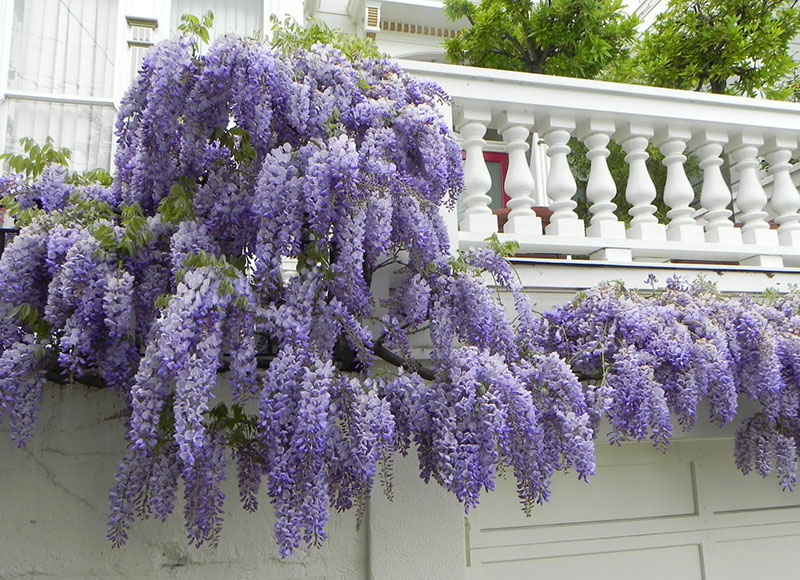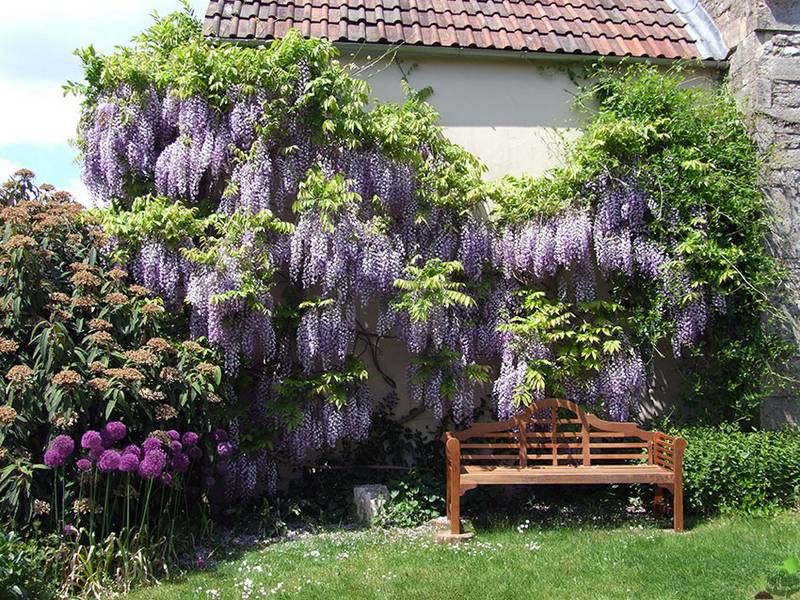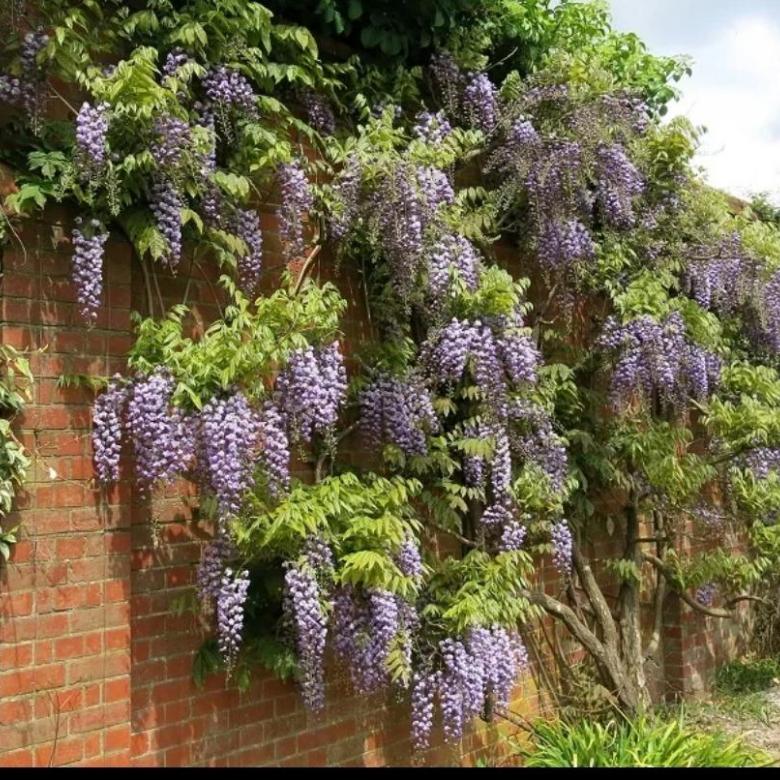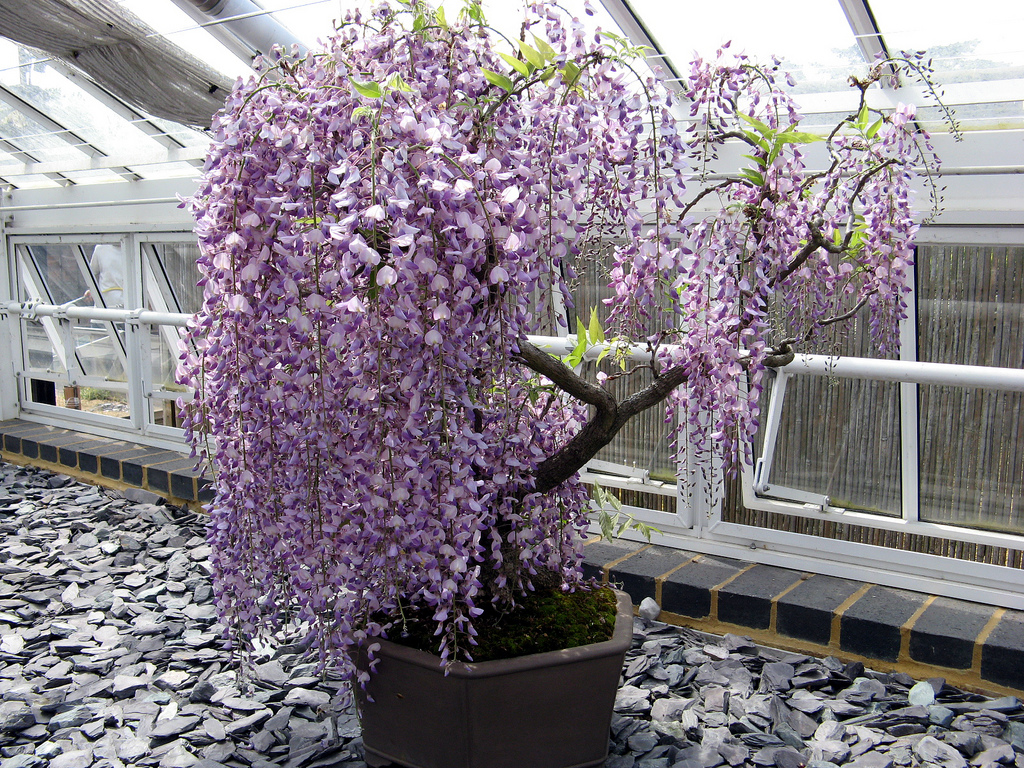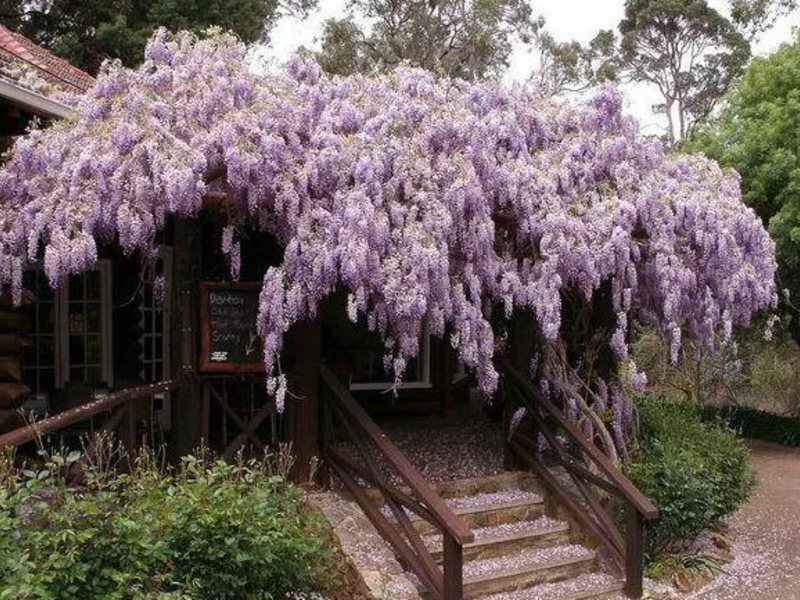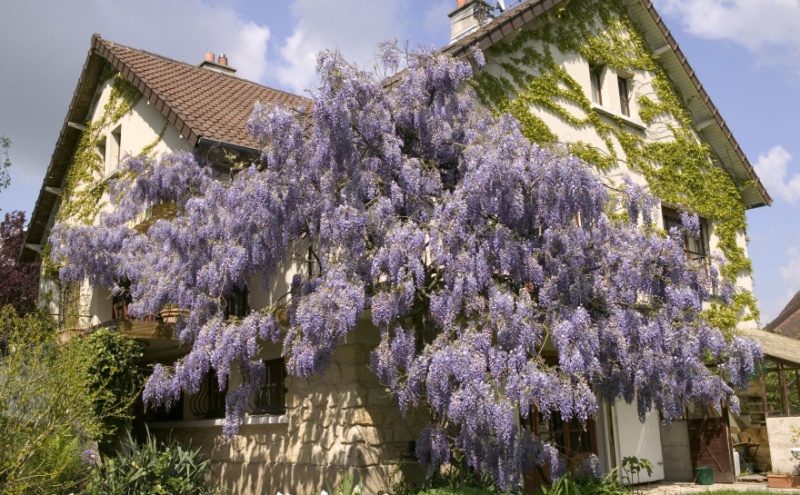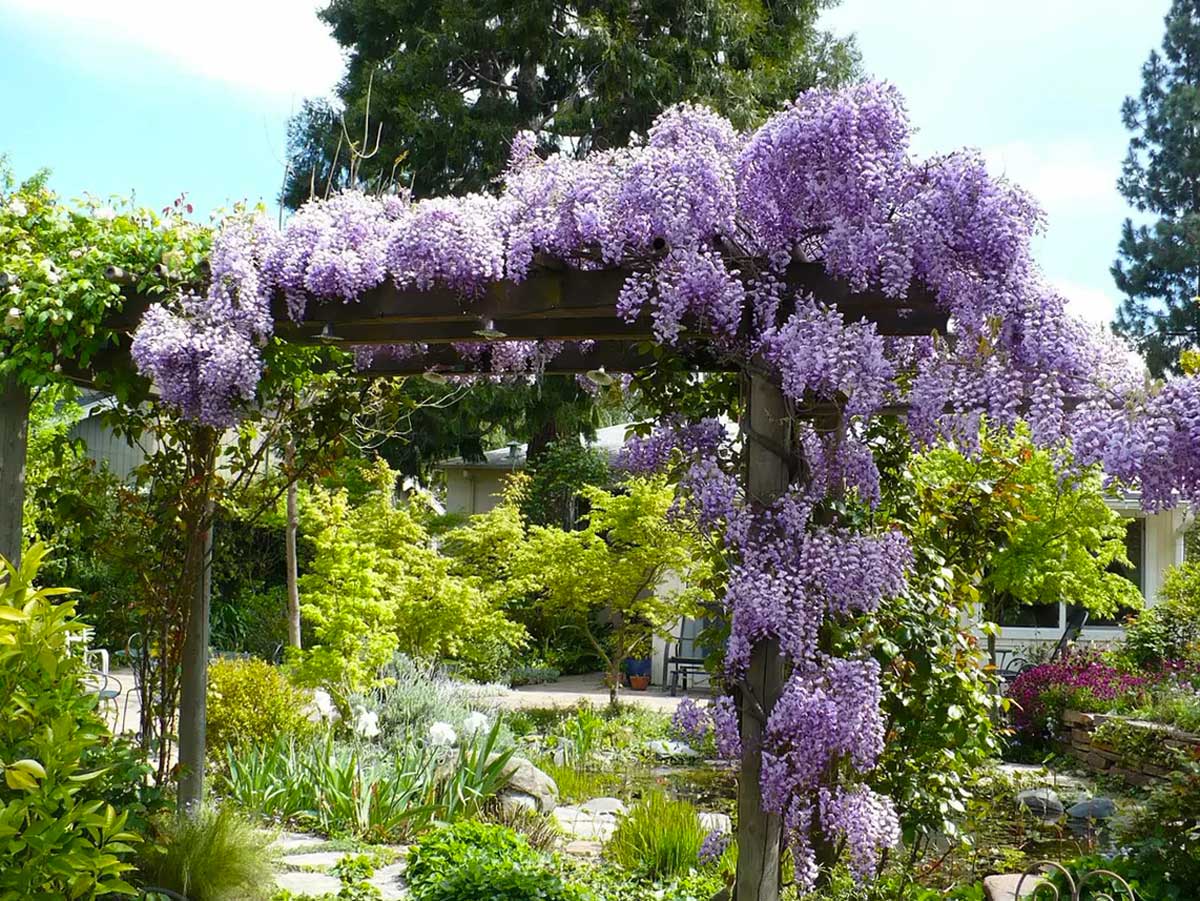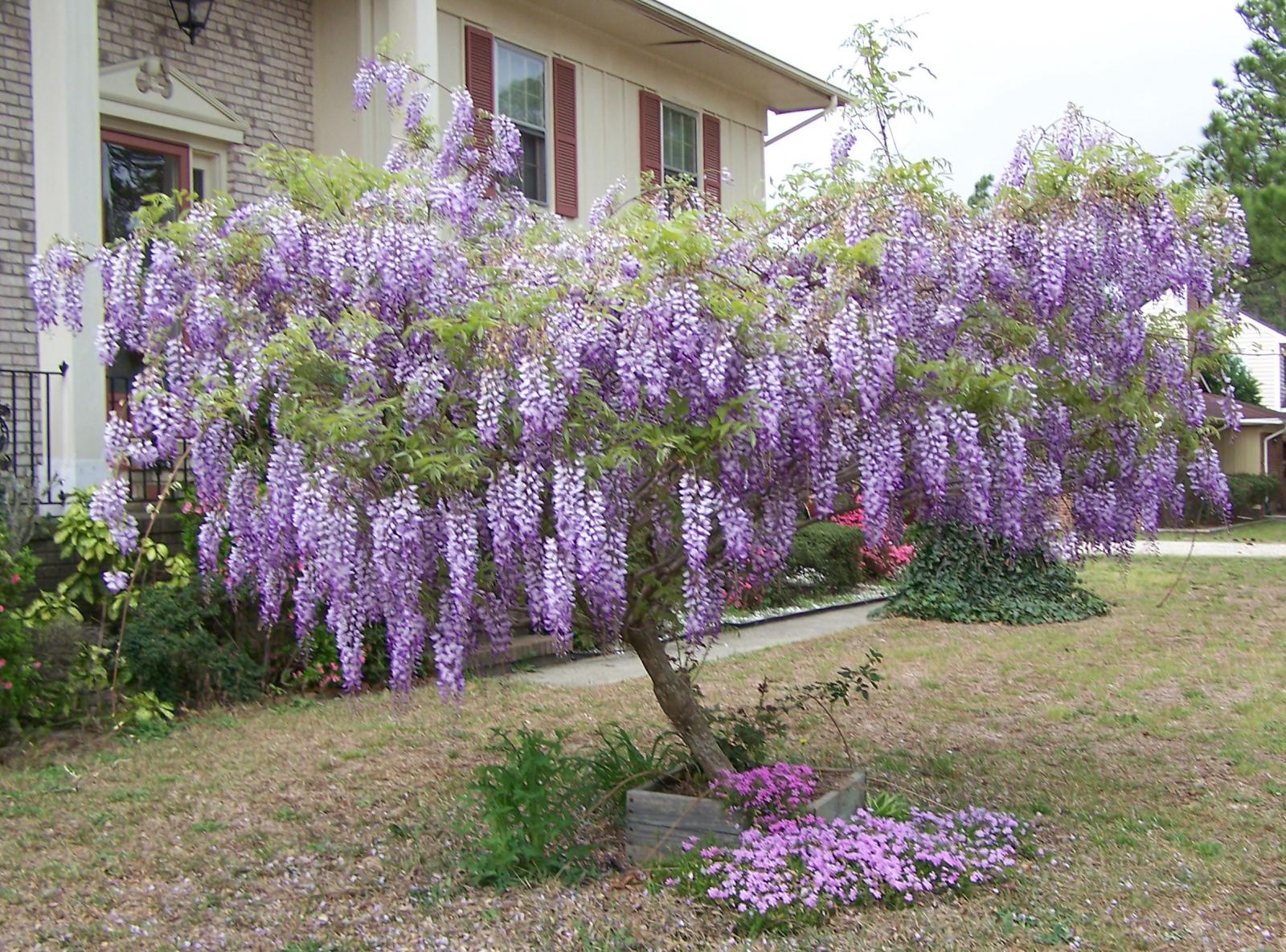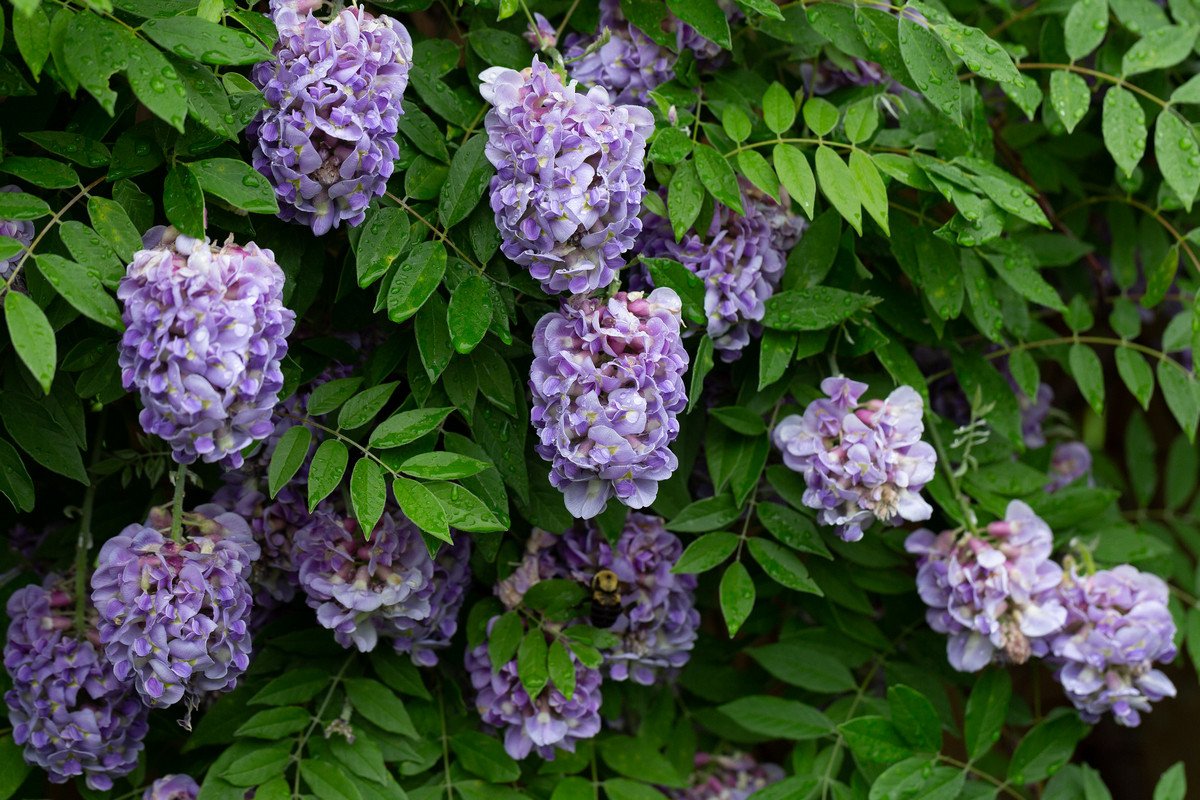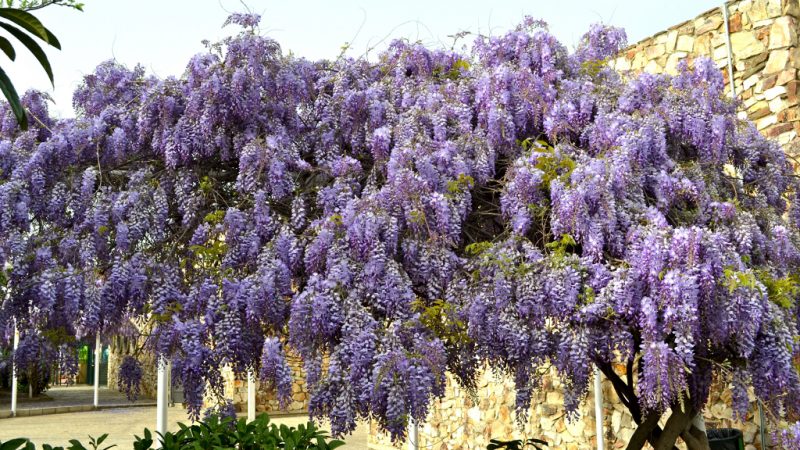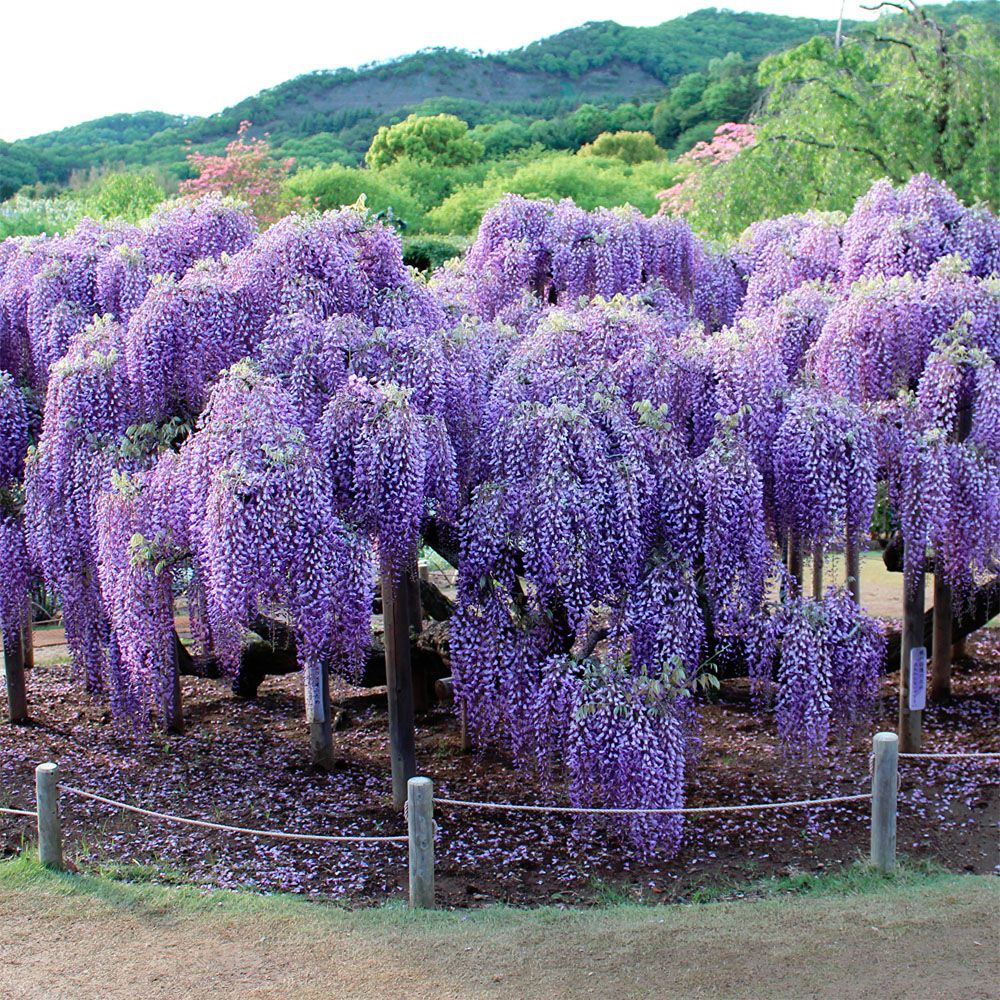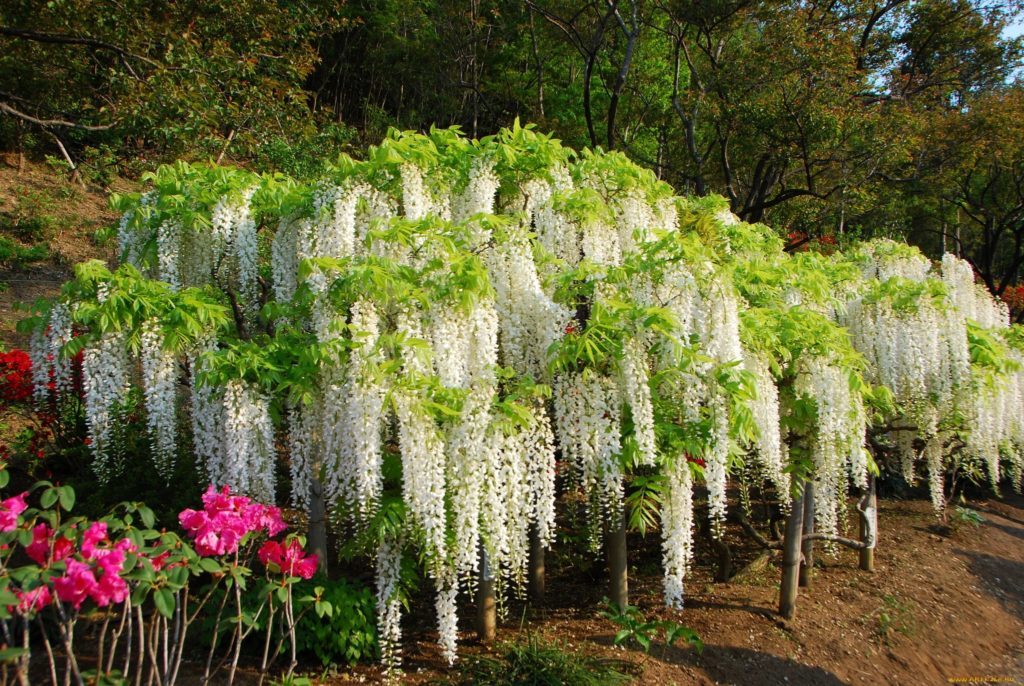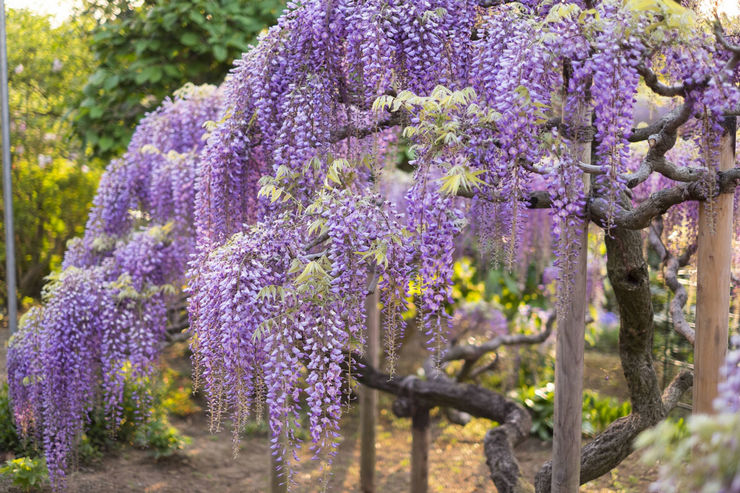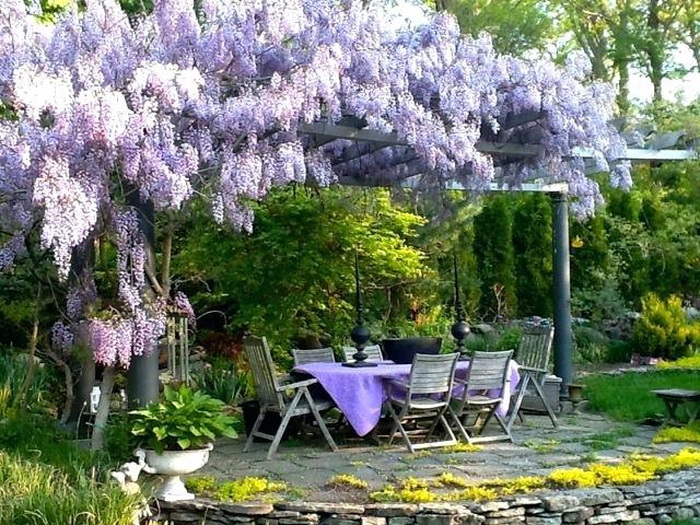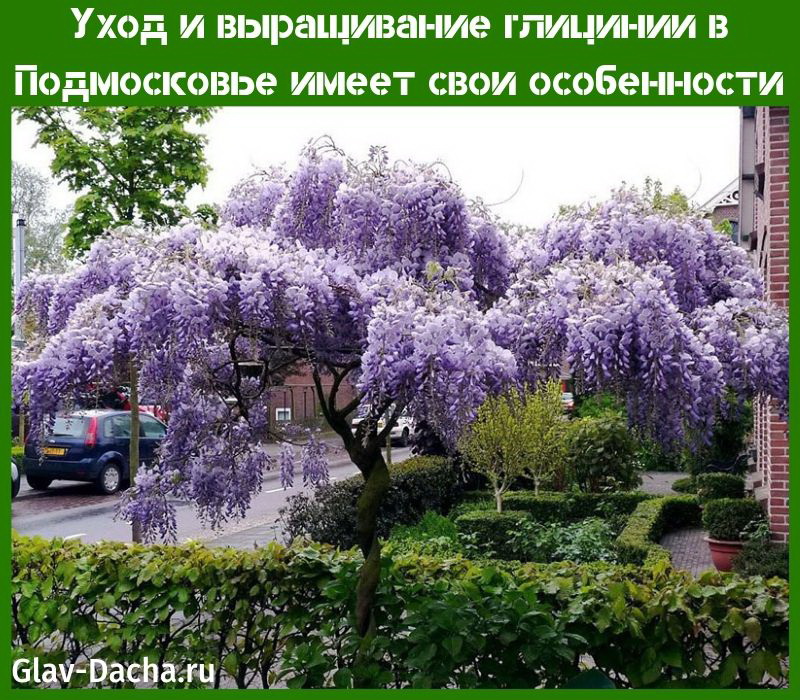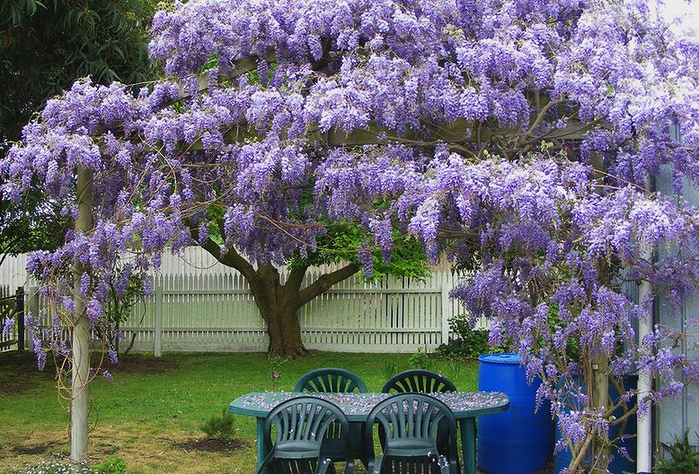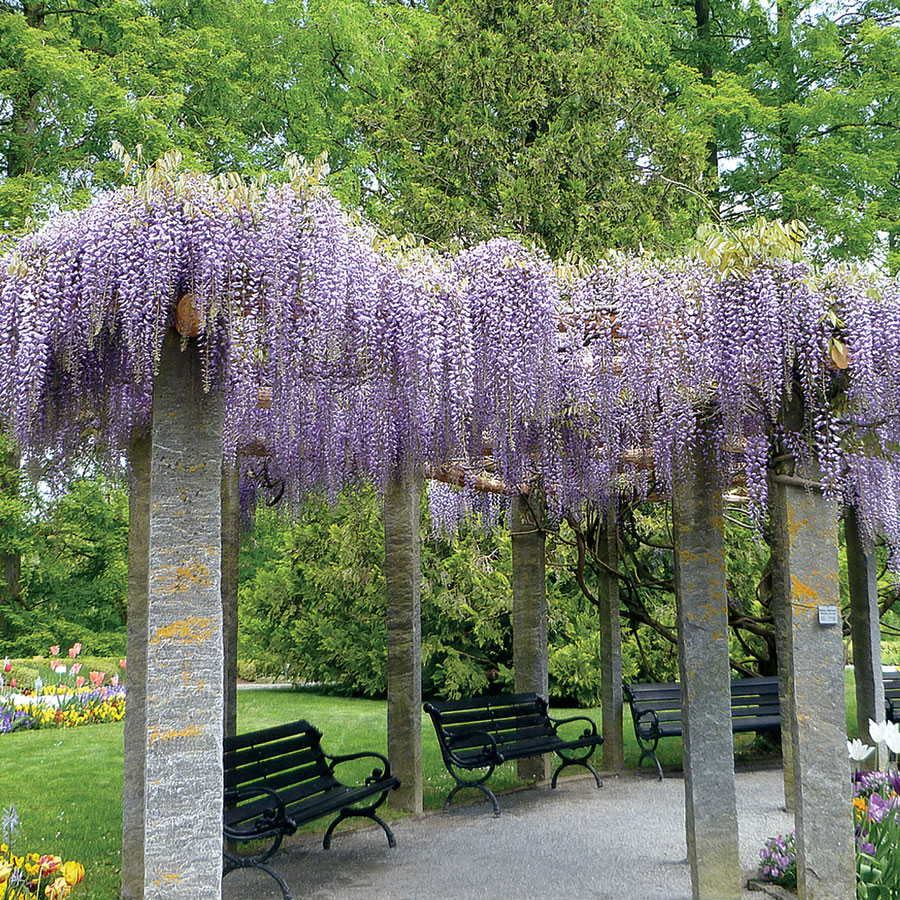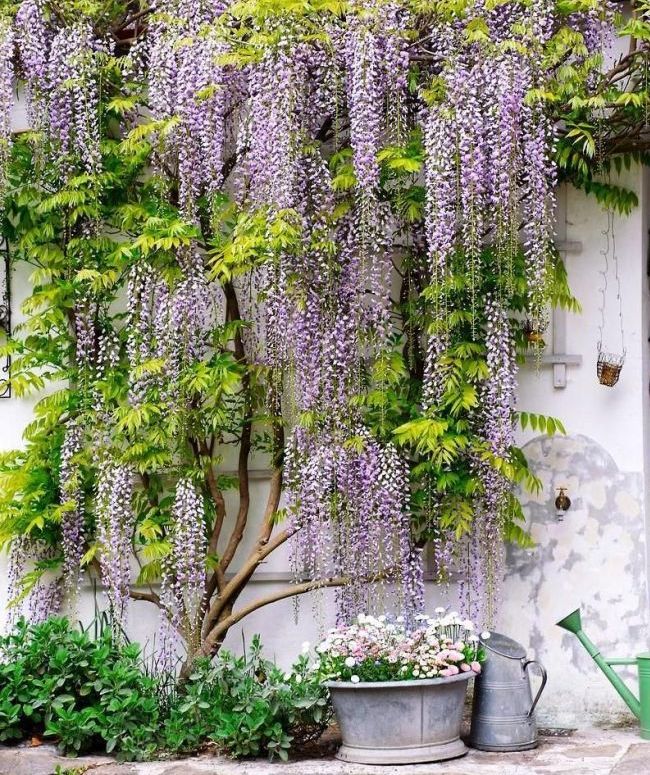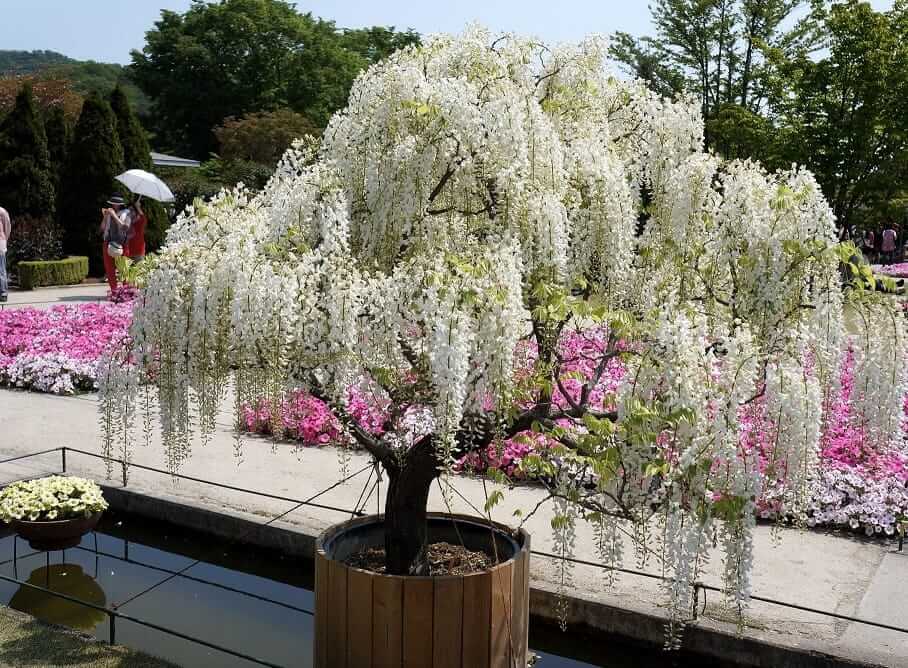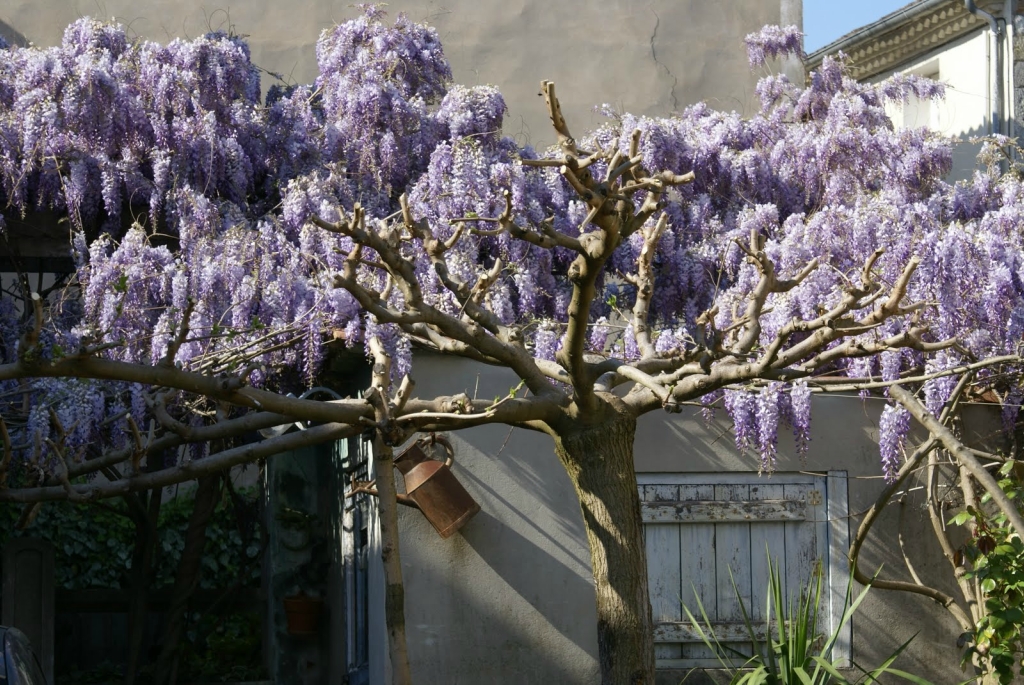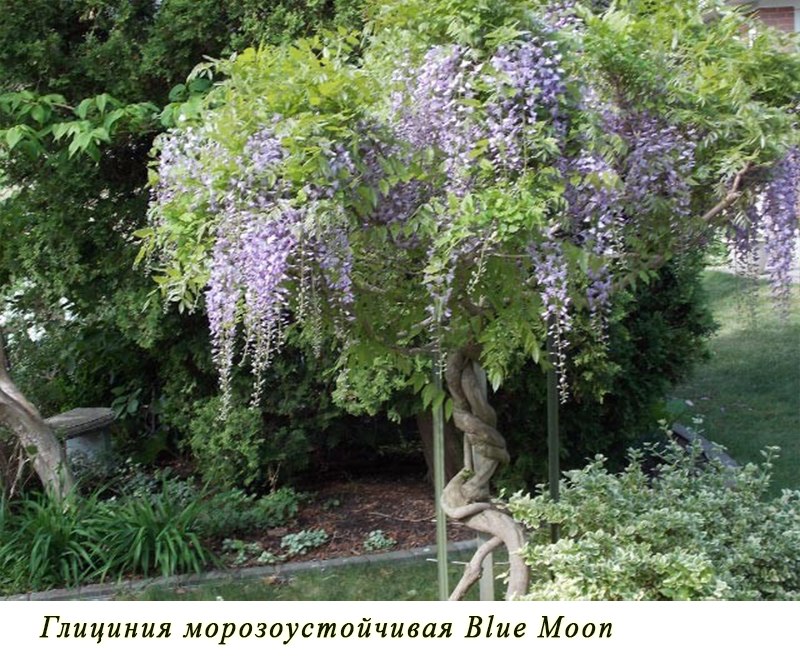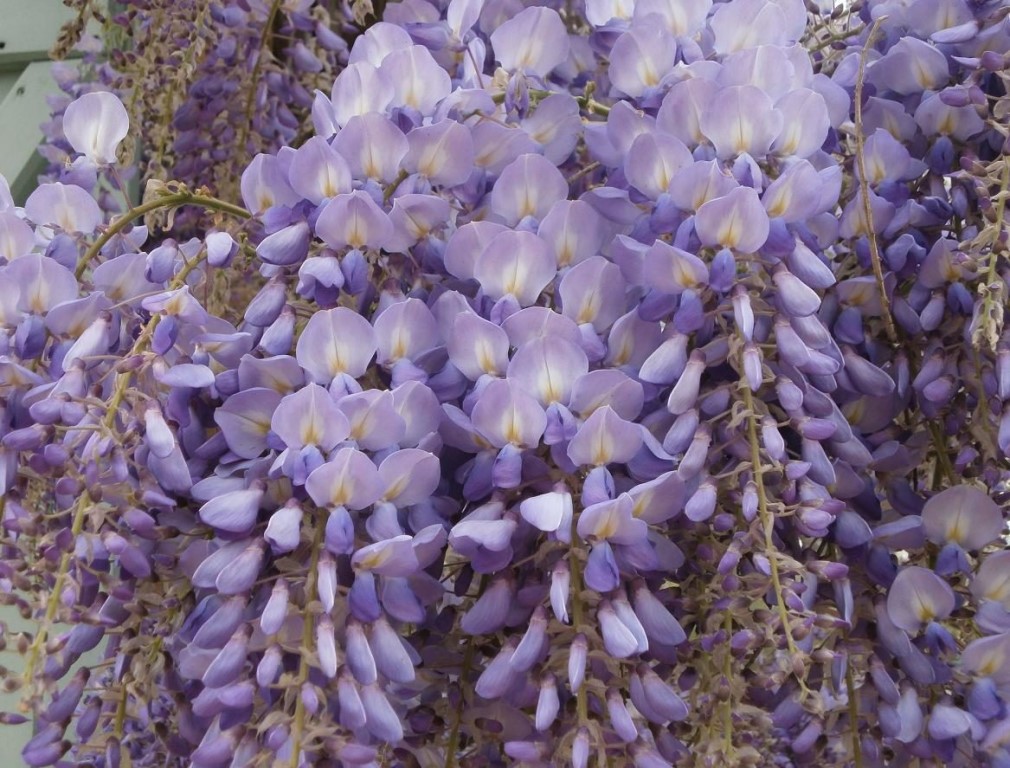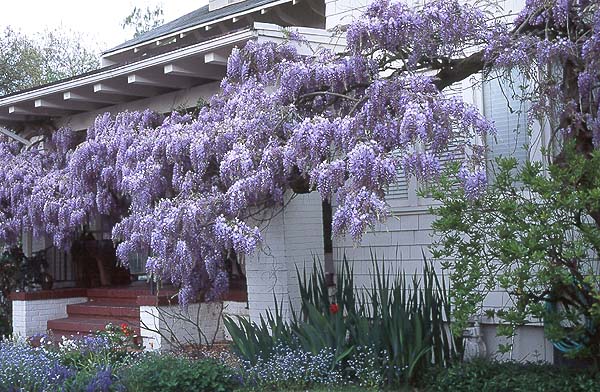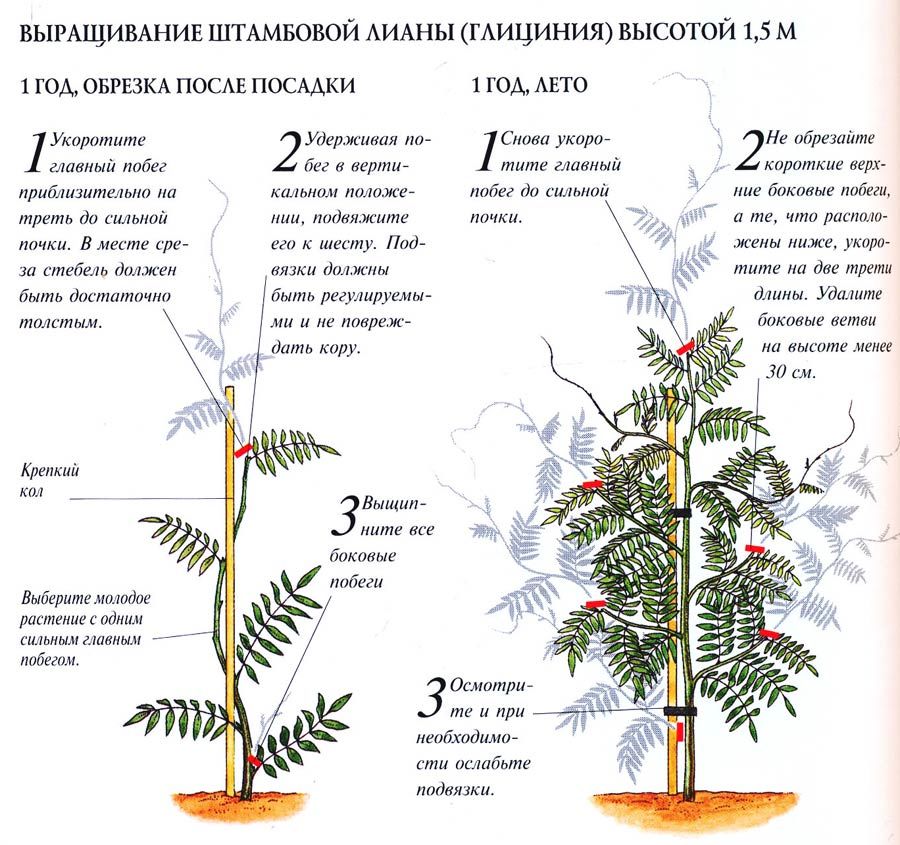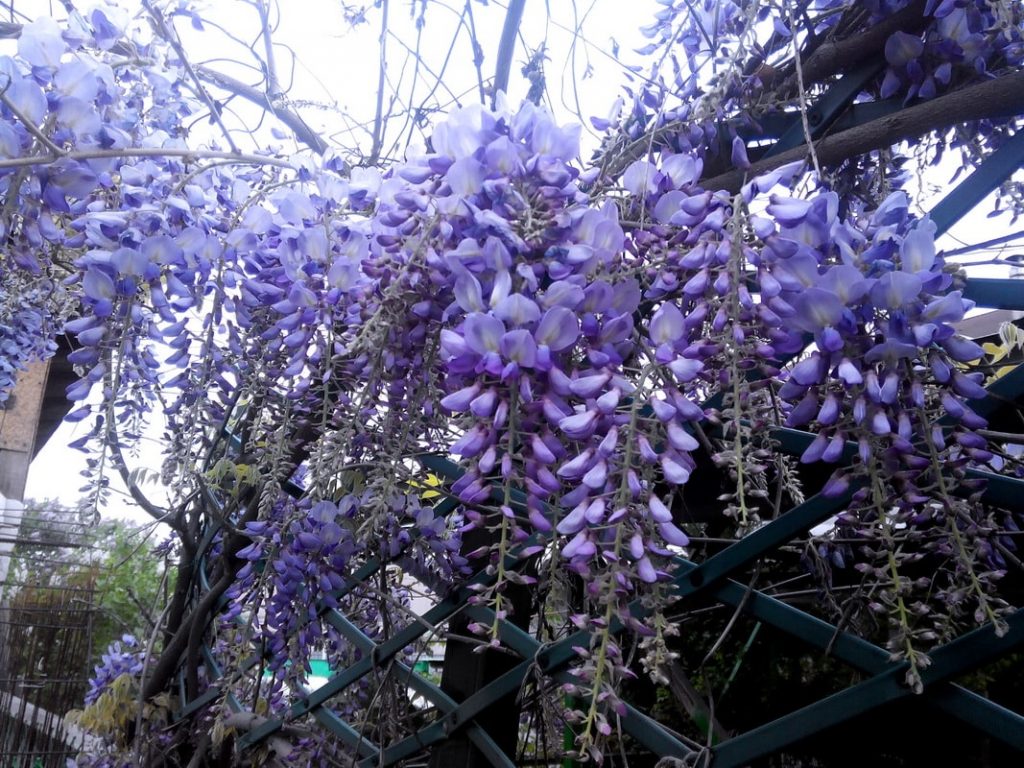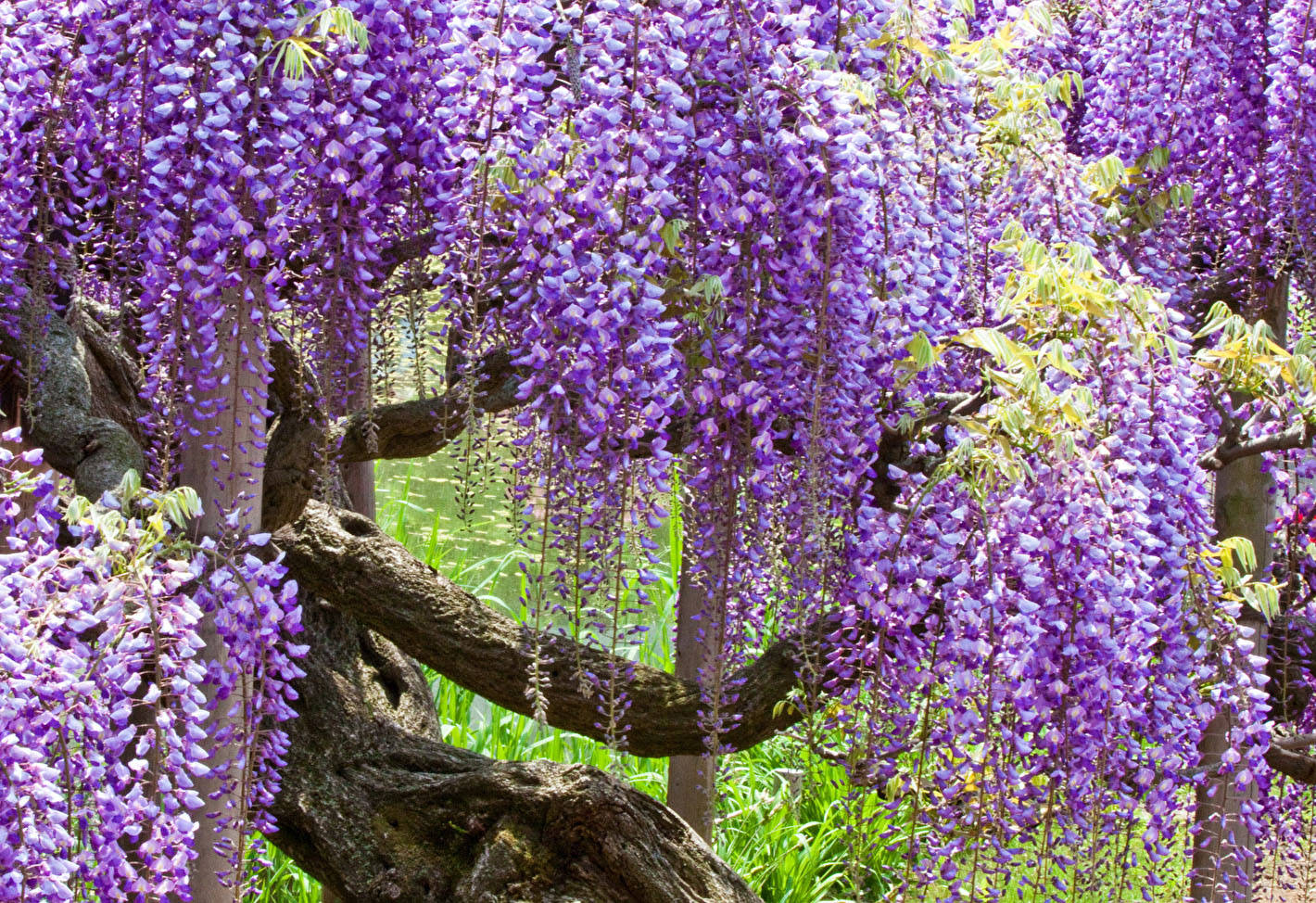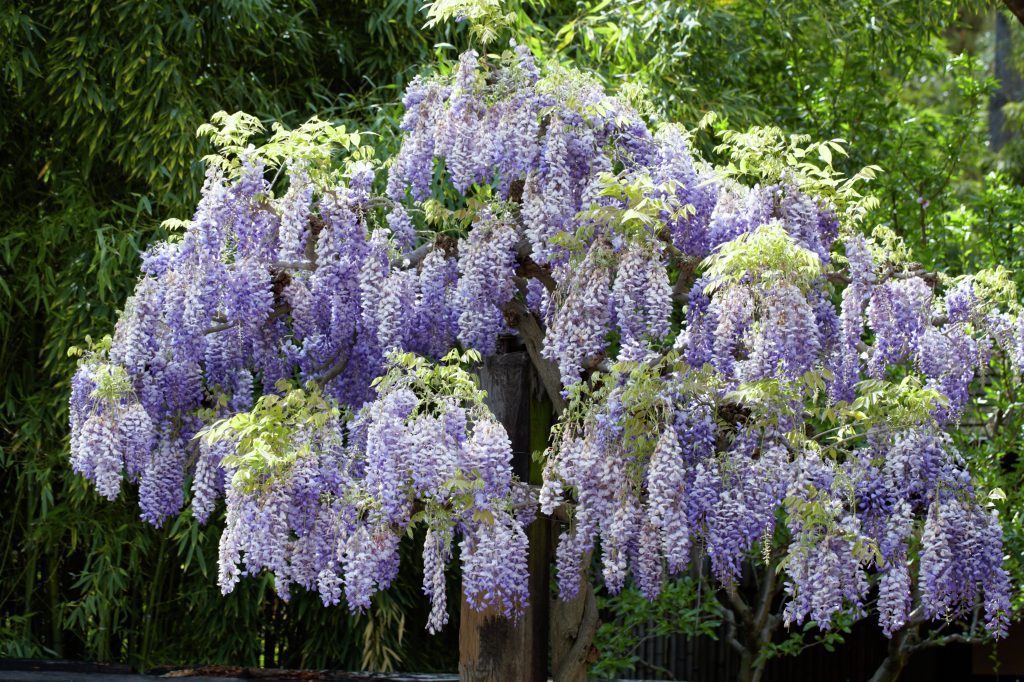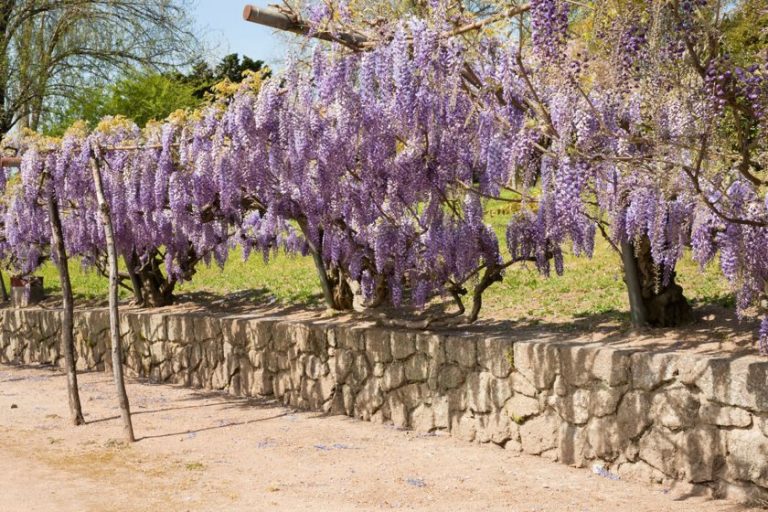Features of growing and caring for wisteria in the Moscow region and the middle lane
To grow an ornamental perennial, it is necessary to choose a sunny location, which is represented by light and well-structured soils. To obtain large inflorescences, the culture needs to provide a sufficient amount of light, and the period of illumination should be twelve hours or more. When planting, it is advisable to lay a drainage layer that will prevent the accumulation of water in the root system of the plant.
 Blue moon variety is characterized by excellent frost resistance
Blue moon variety is characterized by excellent frost resistance
It is necessary to plant seedlings in specially prepared and prepared planting holes, the depth of which should be about a quarter of a meter. Fertilization of planting pits with humus and mineral fertilizers is mandatory. Irrigation activities are performed every day. A very good result is obtained by mulching the soil in the near-trunk circles.
Why doesn't wisteria bloom?
This is one of the most common questions asked by budding gardeners. And the answer to it boils down to four reasons:
Pruning - Wisteria require pruning twice a year in July / August and February
When pruning a plant, it is important to follow certain rules, which will be discussed in more detail below.
The plant is grown from seeds - in this case, you can wait for flowering from 3 to 20 years. Therefore, it is better to propagate wisteria in another way or buy ready-made seedlings in specialized nurseries.
Watering - wisteria needs abundant watering between July and September
It is at this time that the buds are laid for flowering next year. If during these months the liana does not have enough water, you should not expect abundant flowering next summer.
Frost - Spring frosts can sometimes cause bud development before they have a chance to open. The best way to avoid this is to plant your wisteria in a sheltered location.
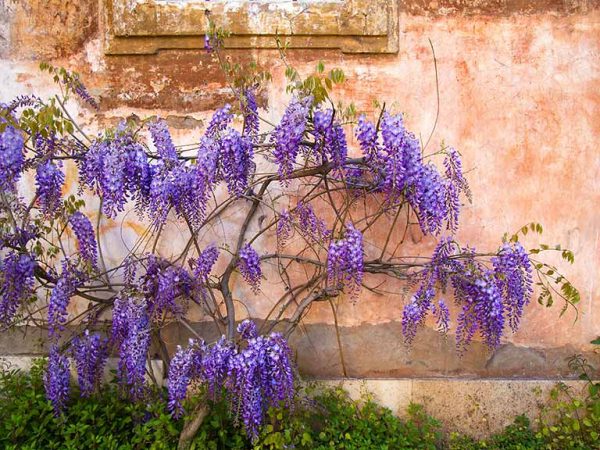 Blooming wisteria
Blooming wisteria
Pests
The most harmful enemies of wisteria are clover mites and aphids.
Aphid
If the leaves begin to dry, the branches bend, the flowers become smaller, and the plant withers, then a colony of aphids attacked the wisteria.
You can get rid of these small parasites with one of the modern insecticides: Fitoverm, Karate, Intavir, Aktellik.
Clover mite
A small parasite with an oval body of an inconspicuous green or brown color. It is very difficult to notice it - the body length barely reaches 0.4 mm. The attack can be detected by characteristic external signs.
The surface of the leaves is covered with small light strokes, then cracks. The affected leaves are twisted.
Acaricides work great against ticks, completely ridding the plant of parasites. You can use Nissoran, Sunmite, Apollo, Fitoverm, Oberon, Omite.
Features of growing wisteria of different varieties
Before buying a vine seedling and planting it in your garden, you should find out which species are suitable for our climatic conditions and what are the features of their cultivation. Wisteria as a genus includes 9 species, but only three are suitable for our area: Chinese, frost-resistant, profusely flowering. When breeding such vines, it is necessary to ensure the following conditions:
- Bright sun. Abundant flowering of wisteria can only be obtained in a sunny area.
- A solid foundation. Liana is a climbing plant, and it needs a good, strong support on which it will grow.
- Stable watering. From spring to summer, the land on which the wisteria grows must be kept moist. The main thing is not to overdo it, the plant does not tolerate excess moisture.
- Top dressing with fertilizers.Like other plants, wisterias need fertilization, especially during the budding period.
- Thorough shelter for the winter. Despite the fact that such a vine is a frost-resistant plant, it is recommended to wrap its twigs with leaves, paper, roofing felt or special covering material for the winter.
- Pruning. For dense flowering, wisteria is cut off 2 times a year (at the end of flowering, after leaf fall).
If the climatic conditions of your region do not allow growing a vine outdoors in the open field, try planting it in a flowerpot, like a standard tree. In autumn and winter, it will decorate the hallway or hall of your home, and in spring and summer it will embellish the terrace or entrance to the house. To form a wisteria crown, you will need to prune the young side shoots several times in the spring.
Chinese (Wisteriachinensis)
The birthplace of tree-like wisteria is China. The plant is characterized by a dense foliage, the length of the shoots reaches 15-20 m in height. The leaf of Chinese wisteria is large (20-30 cm long), has a complex odd-pinnate shape and consists of 7-13 small leaves. The liana blooms with light purple (in rare cases, white) flowers, which are collected in a 40 cm brush and all bloom at the same time. Flowering begins with the appearance of foliage and lasts until the end of summer. This is often repeated in early September.
Wisteria is a thermophilic and light-loving plant, but it develops well in the shade. It is not particularly demanding for the soil, but it is preferable to plant the plant on fertile, moist soil. This vine is well adapted to urban conditions, withstands a short-term drop in temperature to -20C. Wisteria grows quickly, lifting stems up the support from right to left. With systematic pruning, the plant is suitable for growing in pots and tubs.
Frost resistant (Blue Moon)
This plant is native to North America. Wisteria Blue Moon is fast-growing, its maximum length is 8 m. The bush has unpaired leaves (consists of 7-9 leaves) of glossy dark green color. The inflorescence is abundant and dense, reaches a length of 25-30 cm, consists of bluish or blue-purple flowers. Frost-resistant wisteria blooms in early June and blooms for 2-3 weeks.
The main feature of this vine is its good tolerance to extreme cold temperatures down to -40C. It is advisable to plant a plant in a sunny area or on the south side of the building. Wisteria grows on any type of soil, but in order to achieve maximum flowering results, it is recommended to grow it on black soil or loam. It is not recommended to plant a bush in swampy, calcareous places. This type of wisteria is not picky about watering and tolerates drought well. Only young plants need to be systematically watered.
Abundantly flowering or multi-flowered (Wisteria floribunda)
This wisteria was originally developed in Japan. The height of the vine reaches 8-10 meters, has very large leaves (40 cm) with 15-19 small leaves. The size of the clusters of inflorescences reaches 50-70 cm. Wisteria blooms after the leaves bloom, in the second half of May, sometimes again at the end of summer. Flowers bloom gradually, starting from the base of the brush, ending with the bottom.
Multi-flowered wisteria withstands frosts well down to -25C. For lianas, sunny areas with light, moderately moist, loose soil, without stagnant water rich in nutrients, are preferred. Multiflorous wisteria twines around the support with stems only clockwise. The color range of flowers is varied: white, pale pink, pale purple, reddish.
Growing wisteria at home
Wisterias are also grown at home in the form of a formed standard tree, similar to a bonsai. For home maintenance, the smallest and slowest growing varieties are chosen.
From November to February, the domesticated vine should be stored in a bright room with high humidity and a fairly low temperature of 6-10 ° C. Watering for this period must be stopped.From February, you can transfer it to a warmer room and gradually resume watering.
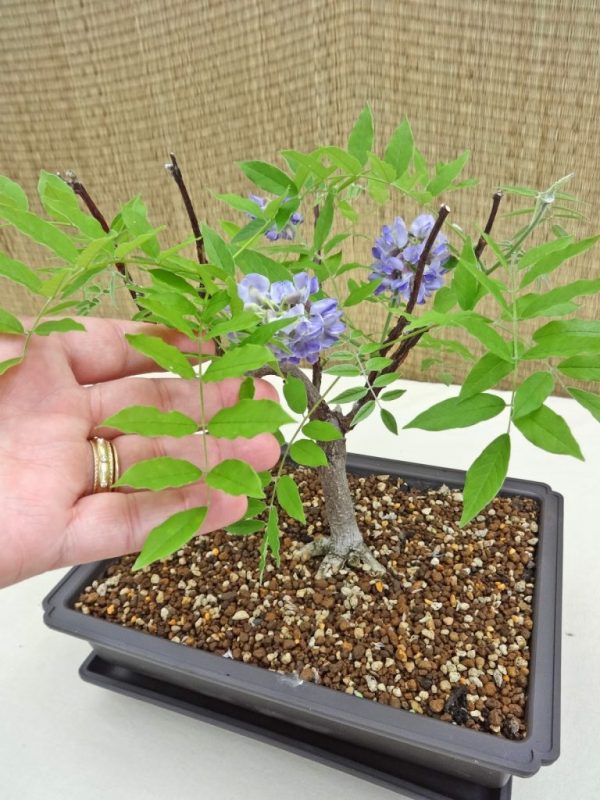 Wisteria growing at home
Wisteria growing at home
Keeping a plant in a warm place in winter can lead to its death. At the beginning of spring, young shoots should be pruned to 3-4 buds and a crown should be formed. Light-loving wisteria is best kept from the southern sunny side. During flowering, it makes sense to feed with any fertilizer for flowering indoor plants.
Pruning should be done twice a year, guided by the same principles as when forming a standard tree in the open field.
 Wisteria seeds
Wisteria seeds
A beautiful wisteria vine can be a real decoration of the garden or home. For successful cultivation, you just need to know a few of its features and follow the rules of care - and then the blooming long-liver will delight you for many years.
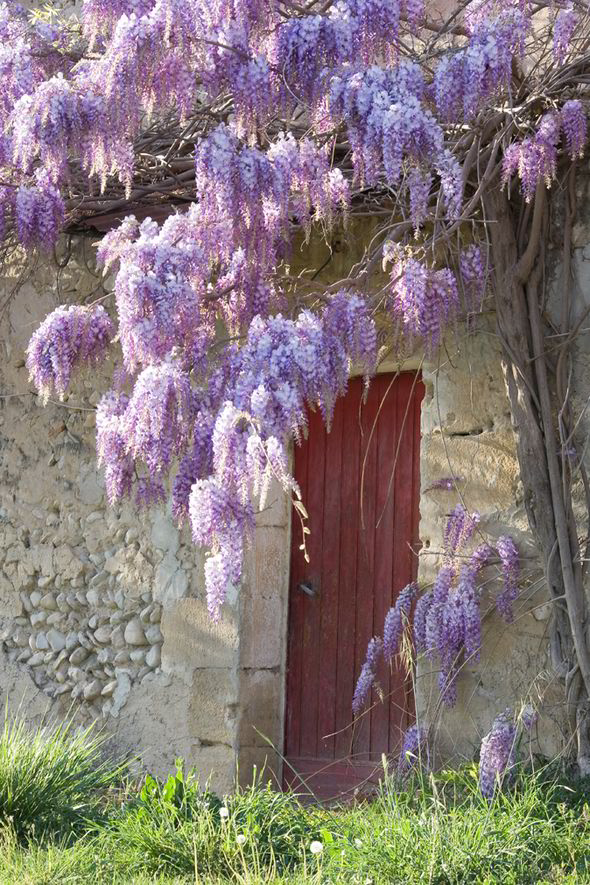 Wisteria blooms
Wisteria blooms
Wisteria, planting and care
Planting creepers
This ornamental shrub is perennial, therefore, for its abundant flowering, you should choose a sunny place, closed from drafts. The soil must be fertile, slightly alkaline, drainage is required.
Planting is best done in the spring after frost. And although wisteria tolerates frost well, it should be covered for the winter with spruce branches, roofing felt or covering material.
It is better to plant wisteria with seedlings. Before planting, the soil is dug up with the addition of mineral fertilizers, then planting holes are dug about 0.5 m, drainage is made from gravel or broken brick.
Plants grown from seeds will not bloom soon, no earlier than 5-10 years.
Care
Support creation. Wisteria grows in one place for a long time, so the support must be reliable, strong and durable, capable of withstanding strong gusts of wind. Liana needs to be tied to a support, so that it is easier to remove before the winter cold. With a calcareous soil, the leaves of the shrub become light and lose their decorative effect.
Watering. Liana is hygrophilous and requires regular watering, but if it is waterlogged, it can shed buds and even a leaf. Therefore, during the flowering period and until the end of August, moderate watering is required.
You can spray the bush.
Timely pruning of a vine is essential for its abundant, lush flowering. Usually flowers are formed on shoots of the previous year and earlier.
Therefore, pruning is carried out at the end of May, leaving shoots up to 30 cm, removing 2 buds, and in the fall, new branches are cut into four buds.
Regular feeding of the plant will help maintain a healthy and beautiful blooming appearance. Requires weekly feeding with solutions of organic and mineral fertilizers. It is advisable to water with a chalk solution once a season (100 g of chalk per bucket). Wisteria belongs to the legume family, so you can't get carried away with nitrogen fertilizers.
 how to plant wisteria
how to plant wisteria
Reproduction
The simplest ways of cultivating a climbing shrub are vegetative: cuttings, layering.
For cuttings in the fall, cuttings are cut and buried in moist soil and keep the winter in a cool place. In early spring, they are planted under plastic bottles or in a permanent place or in a greenhouse.
Reproduction by layering is carried out in the fall: the lower shoot is slightly scarred and sprinkled with earth, leaving only the top. The next fall, they check how the cuttings have taken root. If the root system is insufficient, then the cuttings are not separated from the mother plant.
So we figured out what wisteria is, planting and caring for it. Simple plant care will allow you to grow an amazingly beautiful liana, if you follow our helpful tips.
I invite you to the group for "Country Hobbies"
Wisteria in garden design
Wisteria is not exotic at all for Sochi, Crimea, Caucasus and Transcarpathia. This subtropical beauty liana in such a climate even bothers with its aggressive behavior, weed.But for our region, this is a very promising plant that can be used for vertical gardening, as well as form a standard shape from them.

The wisteria on the southern walls of the buildings is beautiful. It seems that such conditions for its cultivation are needed in the south of Kazakhstan. She will also benefit from the light reflected from the walls, and the warmth of a heated building. Well, if you have the opportunity to provide her with a pergola in the garden, then provide her with a 10-meter coverage, then she will reveal her full potential and create an imitation of the Eiwa tree or the fabulous landscape of Asigawa Park.
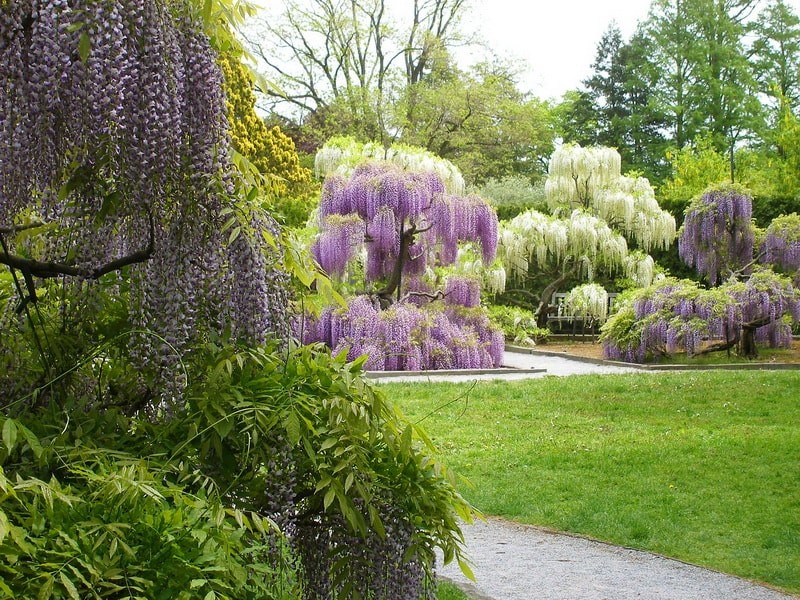
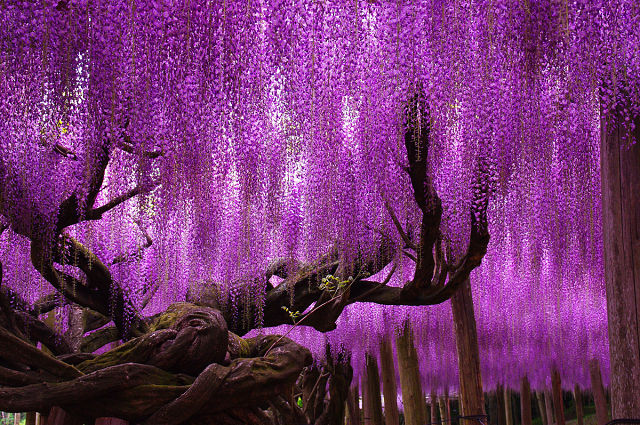
In such plantations as arboretums and parks, long arched tunnels look magical, where varieties of wisteria are selected with transitions from one color to another. And if the outer side of the arches is knocked out with beautiful varieties of lupines, the design effect will multiply: the inner part will be decorated with inflorescences hanging down, and the outer one will repeat the same lines of inflorescences growing from the bottom up.
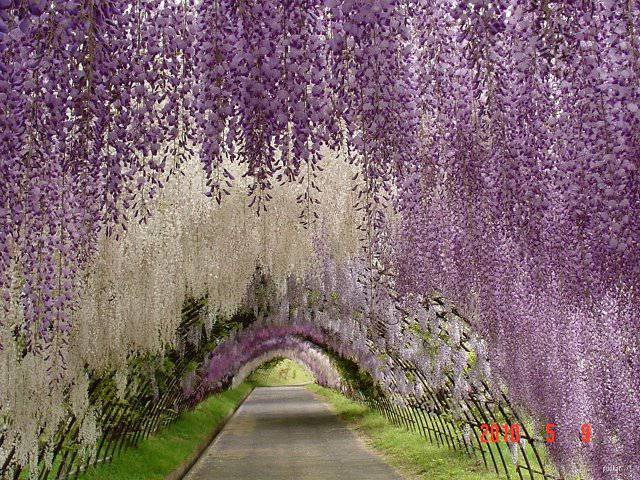
Wisteria can also be grown as an add-on crop in tubs. Then even the most sissy will be appropriate in the garden. It will simply be necessary to bring containers for wintering in premises with a 10-degree mode. Bonsais are beautiful from wisteria - even on tiny trees, tassel inflorescences bloom profusely.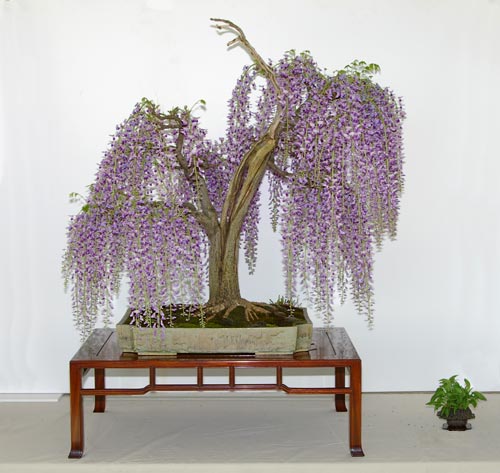
In conclusion, it must be added that besides the obvious beauty, wisteria in the garden improves the ecology. M. Fukuoka populated his garden with acacias, and they supplied nitrogen to all his green friends. Why don't we populate the garden with leguminous plants, cercis, wisteria and lupine instead of bending our backs and hauling dung? The only limitation for such a strategy is the allergy of the owners, because it is known that many have an incredible reaction to the acacia flowering. So be careful when choosing not only climbing plants for the garden, but even simple flowers - the same sweet peas can become an obstacle to the visit of your beloved grandson. We hope you liked our review of wisteria - everyone can do it and grow and care for it (you just need patience), but taking a photo in your own garden is a double pleasure, believe me!
How to plant wisteria?
You can grow wisteria in 3 ways - by seeds, layering and cuttings. Choose the place of purchase of seed and planting material carefully. It would be nice to take a handle from a friend. If none of your relatives is growing vines yet, purchase seedlings in specialized nurseries - the likelihood of contamination of the flower garden with diseased material will be minimized. You can buy planting material only once - at the first planting of the plant. In the future, you will begin to receive cuttings and layering from your plant. But collecting seeds from wisteria, you may not end up with such beautiful vines - heredity does not always work.
With seed reproduction of the plant, you will see blossoming inflorescences on vines after at least 5 years, and with improper planting care - after all 10 years
But this method also has an important advantage - the plant immediately adapts to specific weather conditions - it becomes more frost-resistant. Are you not afraid of difficulties? Then buy the seeds of the selected variety and start planting
Plant seeds either in open ground (more suitable for southern regions), or using seedlings. The second option is preferable. Seed material is sown in the spring in the seedling box no more than 3 cm deep. For planting, use a nutritious substrate - sod and leafy soil, sand. Keep seedling boxes covered with foil or glass in the dark at 20-25 ° C. After a month, young seedlings can be taken out in the sun. Dive seedlings in the phase of 2-4 full leaves
Do this carefully to avoid damage to the root system. Transfer wisteria to an open area in early summer
In the first winter, in order to avoid the death of young seedlings, they must be carefully covered with sawdust or spruce branches.
Picked up wisteria seedlings
To grow wisteria by layering, you need a one-year shoot. In early spring, cut it in the middle. Place the cuttings in the nutrient soil so that it is the place of the notch that is buried in the ground. By the end of summer, the shoot will develop a strong root system, which will allow it to be planted in an open area as an independent plant.
The most popular method among florists is planting wisteria with cuttings. For rooting, an annual shoot 25-30 cm long will be required. Planting begins in March-April using a nutritious substrate (earth, peat and sand). Wisteria will take root well in a box that can be placed at home or in an outdoor greenhouse. The stalk will take root faster if you treat its lower end with a synthetic auxin solution - indolylbutyric acid or heteroauxin. The shoot is placed in liquid to a depth of 3-4 cm and kept like this for a day. Then rinse the cutting with clean water and start planting. Immerse the cuttings in the soil buds upwards at a distance of 5 cm from each other. Sprinkle earth on top and pour it over. In order for the shoot to release the leaves, provide the seedling with increased humidity by covering it with plastic and providing partial shade. Water the wisteria several times a day. After a couple of months, partial shade and frequent watering will no longer be required for the young plant. Move the wisteria to a permanent place in early fall to catch it before the frost.
Wisteria planting rules
You need to plant 1-2 year old wisteria seedlings. When planting a plant, it is necessary to follow simple rules on which the further growth of the plant and its flowering depend. Wisteria should be provided with a brightly lit place with light fertile soil, strong supports on which it will trudge in the future, a reliable shelter in the winter season.
Location
Sunlight is very important for wisteria, it needs to be in the sun for at least 6 hours a day. But there should be no drafts, the best choice would be the southern, southeast, southwest side of the building. For wisteria shoots, prepare and install a durable, strong wind-resistant support in advance. When choosing a planting site, take into account the toxicity of the plant, therefore it is not recommended to plant wisteria near water sources.
Soil preparation
For abundant flowering of wisteria, light, fertile, well-permeable soil is needed. With an acidic reaction of the earth, it is necessary to lime it a little. Just do not overdo it, from a large amount of lime, the vine loses its attractiveness, its leaves become light. Clay soil before planting wisteria must be drained with organic fertilizers. For a seedling, plants dig a deep hole, fill it with humus, river sand, leaf and clay-sod soil, mixed in equal parts.
The best time to disembark
Planting time of wisteria depends on its breeding method:
- Cuttings. Spring is suitable for good rooting. For this, an annual shoot is chosen, an oblique incision is made in the middle of its length. The stalk is planted in this place in soil fertilized with a nutritious substrate. At the end of summer, cuttings with roots are transplanted as intended.
- Seeds. In December, wisteria beans are sown in a greenhouse in drained soil fertilized with a mixture of leafy, turfy soil and sand (ratio 4: 1: 1). To maintain moisture, the sowing is covered with glass or plastic wrap, and removed to a dark place. After 4 weeks, seedlings appear, they are taken out into the light. When the sprouts grow to a small bush, they are planted in an outdoor greenhouse.
Growing thermophilic wisteria

Planting wisteria
Layering in spring and summer. For cuttings we choose annual ripe shoots 20-25 cm long. They need to be rooted in soil from turf, peat, humus and sand (3: 1: 1: 1). At the end of summer, the rooted layers are planted.
Seeds. Note that the method is much more complicated than the first one.You can plant seeds in greenhouses in November-December or in the ground in spring. The soil should be loose - leafy, turfy soil and sand (4: 1: 1). Cover crops with glass or a plastic bag for high humidity
And we put it in a dark place - this is important. Seedlings should appear only after 3-4 weeks
Then we take out the seedlings into the light, slightly shading them, and dive when the first 2 leaves appear.
Growing wisteria
- Bright sun. For abundant flowering, wisteria should be in the sun for at least half a day.
- Strong supports, on which wisteria, which grows strongly over time, will curl.
- Moderate watering from spring to late summer - keep the soil slightly moist. Excess water does not tolerate well.
- Light nutritious soil.
- Top dressing with liquid fertilizer once a week during the budding period.
- Good shelter in winter, especially in central Russia. There are varieties that can withstand -20 ° C, but no more.
- Pruning at least 2 times for more abundant flowering. The first - at the end of flowering, while shortening all lateral shoots by two-thirds. The second is after falling leaves. All lateral branches are cut off, leaving only 3-5 buds.
Types of wisteria
Chinese wisteria (Wisteriachinensis) has spectacular light purple, rarely white flowers. It can grow up to 15-20 m. The foliage is dense, the clusters of inflorescences are 30 cm long. It blooms almost all summer. Forms fruits - beans up to 15 cm long. It is widely distributed in the south of Russia and, accordingly, is very thermophilic. If the vine is systematically cut off, it can be grown in a tree-like standard form.

Abundantly flowering, or multi-flowered wisteria (Wisteria floribunda) with violet-blue flowers. Reaches 8-10 m. The brushes of this wisteria are longer than the previous one - 50 cm. And it blooms 2-3 weeks later. It is more frost-resistant (down to -23 ° C) than Chinese wisteria.
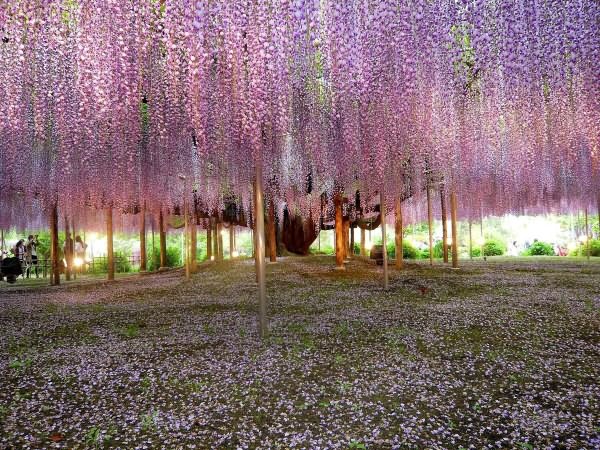
Beautiful wisteria (Wisteria venusta) with double white and purple flowers. It can grow up to 10 m. The length of the inflorescences is about 20 cm. Flowering lasts from May to June. The fruits are beans 20 cm in size.

Shrub wisteria (Wisteria frutescens) has a purple-blue smaller size than Wisteria venusta. Reaches 12 m in height. It has been growing in Crimea for a long time. Can be grown in a container.
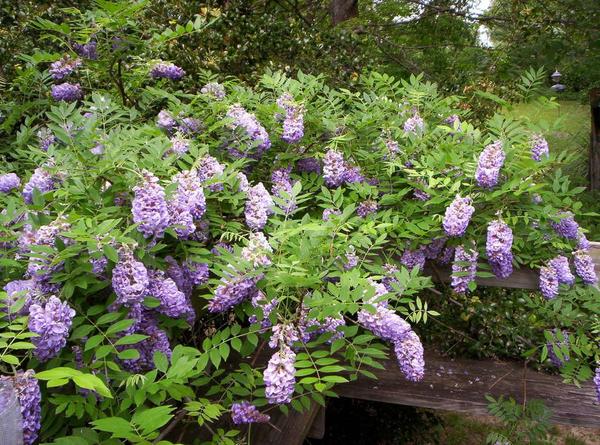
Japanese wisteria (Wisteria japonica) has white flowers. Less hardy and beautiful than other species. Grows on the Black Sea coast of the Caucasus.
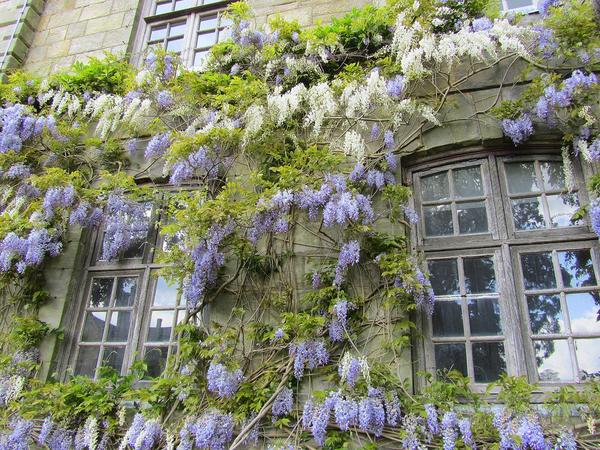
Vera, Biysk
MarfaA, thank you very much for your informative answer. The decision was made, in the spring I buy a seedling. I already know where I will put him.
marishkawork, mine also did not react in the first year, it probably took root. In the second year it gave an increase from 30 cm to 3 meters. This year I hope to see flowering. But! The plant must be cut in autumn and spring, each branch is a third from the end. Also take an interest in the articles, I do not remember exactly, it seems that flower buds are laid on the branches of second years. In general, I want to say to those who are still tormented by the question of seeds or seedlings. I came to the conclusion -better seedlings. Advantages: 1) Saving time for growing to a full-fledged seedling, 2) A varietal seedling is grafted (which, in the absence of experience, cannot be done by yourself, because the grafting is done at the root) 3) flowering begins significantly earlier (when grown from seed, up to 8 -10 years, and from soot-for 4-5 years).

views
Planting and care rules in the open field
Wisteria prefers to grow in subtropical conditions. It is possible to grow it in latitudes located north of the Caucasus, Stavropol, Crimea, but it will not work to achieve abundant flowering. For the middle lane, breeders have bred frost-resistant varieties intended for a temperate climate.
Timing recommendations
Most often, wisteria is grown from ready-made seedlings, which are determined for a permanent place in open ground in the spring, when the frost ends. Although most varieties of perennial vines are winter hardy, you should not risk young plants.
Site selection and preparation
For planting wisteria, a place is carefully chosen, since it is determined there for many years. It should be illuminated by the sun, closed from drafts. Fertile, well-drained, slightly alkaline soil, rich in nutrients, promotes long-term blooming of wisteria. Before planting, the soil is carefully dug up, weeds are removed, mineral fertilizers are added, holes for seedlings are prepared.
Landing scheme
After the soil for planting wisteria is prepared, the plant is planted according to the scheme:
- Dig holes 70 cm x 70 cm x 60 cm.
- Drainage is laid at the bottom.
- Pour soil with mineral fertilizers into the pit.
- The seedling is installed strictly vertically.
- The voids are filled in so that the growth point remains above the soil surface.
- Pour with warm, settled water.
- The trunk circle is mulched with peat or grass.
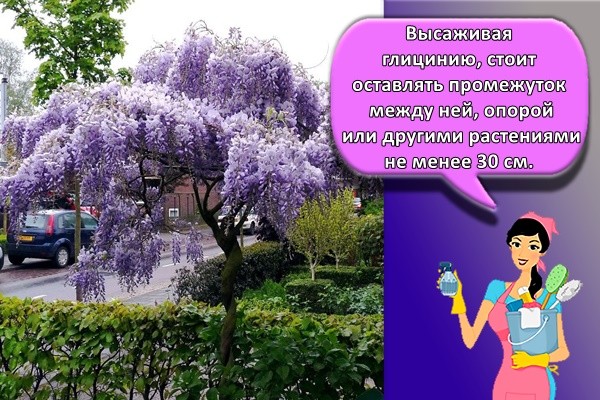
When planting wisteria, it is worth leaving a gap between it, support or other plants of at least 30 cm.
Watering mode
Wisteria prefers moderate irrigation. It feels bad both in waterlogged and too dry soil. It is enough to water the plants once every 7 days in a volume of 10 liters under one bush. Additional moisture is required during the budding period so that future flowers do not fall off. Starting in autumn, watering is reduced.
Spraying
Watering wisteria can be alternated with spraying its crown. To prevent the roots from rotting from stagnant water, in hot weather, you can carry out a light sprinkling-spraying of the foliage instead of increased moistening of the root system.
Top dressing
To maintain flowering, wisteria is fed weekly. Complex fertilizers and organic matter help to restore the strength of the vine, which can increase its length by three meters per season.
Pruning
It takes about three years for the main branches of wisteria to form. After the formation of the "skeleton", excess shoots are annually cut out so that the lateral ones grow, where flower buds are formed. In order to rejuvenate the vines, it is recommended to remove one shoot annually, sending a new, young one to replace it.
Summer
The main shoot of wisteria in the summer of the first year is cut to a highly developed bud, and the side ones are short. In the second year of life, the main shoot of the vine is pinched again, and the side branches are shortened to the length of the main stem. A year later, in the summer, the shoots are cut by a third so that the crown becomes thicker, and the lower side ones are completely removed.
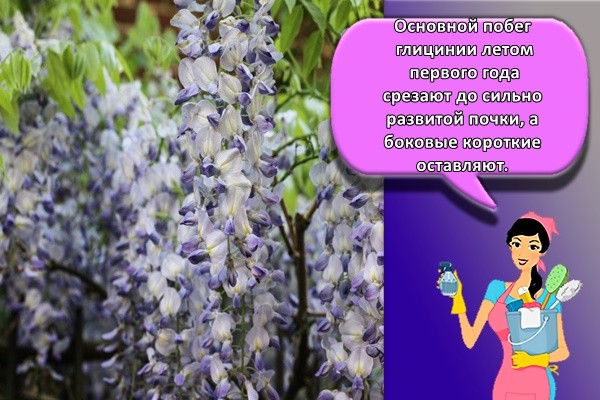
Winter
In winter, the main and other shoots that have grown after summer pruning are shortened. The previously cut branches are shortened by one third. Lateral shoots are cut off to three buds. In the second and third years, winter pruning is carried out in the same way.
Preparing for winter
The shelter of wisteria for the winter begins with the onset of the first frosts. Its roots are carefully spud, insulated by mulching, the liana is removed from the support, laid on shields, covered with spruce branches, dry foliage or straw, and on top with covering material. In winters with little snow, they are additionally covered with agrofibre.
For the first time, wisteria blooms at the age of three. The first buds appear in May. They are collected in large inflorescences up to 35 cm long. In the southern regions, flowering can be repeated up to three times. So that the plant does not lose its strength for the formation of fruits, it is recommended to remove wilted flowers.
What should be done to make the vine take root?
The development of wisteria from cuttings depends on many factors. What if you can't root the vine? In order for the plant to be guaranteed to take root, gardeners recommend taking into account several nuances:
- During autumn pruning, it is necessary to select the correct planting material.
- Only the stalk that overwintered with dignity will germinate successfully.
- Do not ignore the preliminary soaking of the plant in synthetic auxins.
- After planting, the plant needs to provide diffused light, high humidity and sufficient moisture.
- If there are doubts about the sufficiency or excess of light, then to save the situation, it is enough to move the box to another place.
- If the room has low humidity, it is recommended to put the box in a pallet with pebbles filled with water.
Wisteria is an unpretentious plant. If you create suitable conditions for her and take care of the nutritional value of the soil, then the vine will not cause any trouble to its owners. Now you know how to grow wisteria from a cuttings.
Breeding methods at home
Next, consider how to propagate a plant at home.
Horizontal layering
How to breed a plant using horizontal layering:
- Choose a long shoot on an adult plant that has grown a year earlier.
- Make a groove under the shoot.
- Fill with prepared soil mixture, water abundantly.
- Cut the buds of the shoot.
- Place the shoot in the groove, secure with wire or pins.
- Sprinkle with earth, tamp it slightly, leave the top in the air.
- Under favorable conditions, roots will develop from the incised buds by early fall.
Below you can watch a useful video about the propagation of wisteria by layering:
Graft
- For grafting, you need an off-grade wisteria seedling at least 3 years old, which has already had a flowering period.
- After autumn leaf fall, dig up the plant, separate the stem from the root.
- Place the root in a pot of sand, put in a cool and dark room.
- In early January, transfer varietal seedlings to warmth.
- The length of the cut of a varietal plant for grafting is 6-10 cm. The buds should ripen on it.
- A neat 2 cm cut is made on the roots of off-grade wisteria and in the lower part of the varietal cuttings.
- 2 weeks after transferring the plants to heat, connect the cuttings with the roots at the cut points, fix.
- Plant the resulting structure in fertilized soil, cover with glass or foil to achieve a greenhouse effect.
- Within a month after vaccination, shoots will appear from the axillary buds. In the spring, the plant can be planted in a pot.
Seeds
How to plant a plant with seeds in spring:
- In October, ripe seeds are harvested from wisteria.
- In the spring, sowing is carried out in a container, in fertilized soil and covered with glass or oilcloth.
- A month later, when some of the seeds germinate, young shoots are taken out into the fresh air.
- It will be possible to plant seedlings in pots in 2 years.
To learn how to grow wisteria from seeds at home, read here.
Cuttings
- A popular and easy way to breed wisteria.
- In the fall, last year's (maternal) shoot is cut off.
- Cut it into several cuttings with buds.
- A container is laid in a prepared nutrient substrate.
- Until late spring, they are kept in a dark room.
- In May, cuttings that have sprouted and have taken root are transplanted into a tub or pot.
More information about propagation of wisteria by cuttings is described here.
Growing from seedlings
Reference. Growing wisteria from a finished seedling is much easier than propagating it yourself.
How to grow a flower from a seedling? Sapling selection:
- It is worth purchasing a one-year-old or two-year-old wisteria seedling - such a chance to take root is higher than that of a very young plant.
- The choice of a seedling variety is made taking into account the climatic conditions of the area in which it will be planted.
- When choosing a seedling, you need to know exactly how it will be grown (in a room or outdoors), since not all wisteria varieties are able to grow in a pot on a windowsill.
- It is reasonable to buy a seedling only from trusted people, since there are always those who give out another plant for what the buyer needs, taking advantage of the inexperience of novice gardeners.
Next, we will tell you how to properly plant a plant in spring.
Step-by-step planting instructions:
Choosing a place. The place in the room where the wisteria will be grown should be well lit by the sun, protected from wind and drafts. The plant is kept on the sunny side, taken out to the balcony for the summer.
Timing.Planting is done in late spring.
Soil preparation. The plant is able to adapt to various types of soil, however, for its comfortable existence, the soil is chosen light, slightly alkaline, drainage is placed under it.
Watering and feeding. Before planting, the soil must be watered abundantly and fertilized with complex mineral fertilizer.
Landing. Make a depression in the ground of such a size so that the root system of the plant is not damaged when it enters it.
Dip the root of the seedling into the prepared recess, sprinkle the area around the plant with soil, and tamp it carefully.
Re-watering. after landing.
Garden design combinations
The appearance of wisteria is very impressive. She looks great in both individual and group plantings. Other flowering garden plants are able to highlight the beauty and singularity of the vine.
Tulips
The flowering dates of wisteria and tulips are the same. The composition of a large number of red buds against the background of a green lawn is set off by the delicate colors of wisteria. Elements made of natural stone, a wrought-iron fence or a support for creepers can be a good addition.
Daffodils
White and yellow daffodils can be placed in early spring under wisteria vines in flowerpots. containers, pots. After flowering, they have a slightly sloppy appearance. By removing the containers, you can avoid the unattractiveness of daffodils.
Hyacinths
These bulbous are classified as primroses. Combined with tulips and daffodils, they create the perfect backdrop for wisteria. Dark purple hyacinths look especially impressive, having a brighter shade than the blue brushes blooming on vines.

Muscari
For a combination with wisteria, you can pick up muscari in all shades of blue. They are planted under the standard forms of plants, in the near-stem circle.
Imperial hazel grouse
Different heights of flowers, from 10 cm to 120 cm, allow using the imperial hazel grouse both for individual plantings and in the shade of wisteria. They look good at the entrance to the gazebo, near the reservoir, in the rock garden.
Hibiscus
The plant looks great in a shrub curb next to a wisteria of short stature. It is worth complementing the composition with evergreens.
Purslane
Due to the fact that the purslane has a rich color palette, it is customary to decorate the space near the paths with them. As a lower tier under the falling wisteria brushes, they look very advantageous.
Platycodon large-flowered
The plant is decorative not only during flowering, but also in autumn due to its beautiful foliage. For stony soil under wisteria, dwarf varieties of Platycodon are chosen, which are planted along with conifers.
Daylilies
Daylilies are considered a versatile plant for landscaping. It is unpretentious, has many shades, blooms for a long time. Daylilies of contrasting colors, planted in large and small groups, go well with wisteria.

